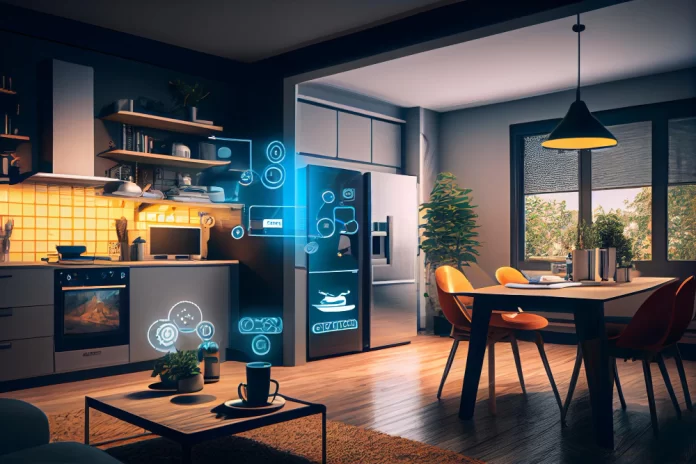The idea of sustainability has become increasingly popular in a time that is characterized by environmental awareness. People are actively looking for ways to live sustainably and lower their carbon footprint. As technology develops, we now have the chance to incorporate sustainability into our homes by fusing smart home technology and environmentally beneficial behaviors. In this post, we’ll look at how to design a sustainable smart house that makes use of cutting-edge technologies to save energy, resources and encourage a more eco-friendly way of life.
Energy-Efficient Lighting
Using energy-efficient lighting is one of the easiest yet most effective strategies to create a sustainable smart home. Traditional incandescent bulbs are less energy-efficient and last for a shorter time. Choose LED or CFL lights instead because they are more energy-efficient and durable. By enabling you to adjust lighting settings, schedules and even color temperatures through applications or voice commands, smart lighting systems go one step further. Your electricity bills can be lowered by automating the use of lights based on occupancy sensors and dimming them when not in use.
Smart Thermostats and HVAC Systems: Heating, ventilation and air conditioning (HVAC) systems use a significant amount of energy in a typical home. You may improve energy use by installing a smart thermostat, which gives you precise control over your home’s temperature. These smart appliances can remember your preferences, change settings based on occupancy and even use geofencing to detect when you are getting close to home and begin altering the temperature. Smart thermostats may considerably minimize energy waste and lower your carbon footprint by providing efficient heating and cooling.
Renewable Energy Integration
Think about incorporating renewable energy sources to advance your eco-friendly smart home. A well-liked method for producing clean electricity is solar power. They take energy from the sun and transform it into useful power for your house. You can offset all or a portion of your power use by adding solar panels to your roof, which will lessen your dependency on fossil fuels and the emissions of greenhouse gases. Smart home systems can keep an eye on and manage energy production and consumption, optimizing the advantages and assuring effective use of renewable energy.
Smart Appliances and Energy Management
Smart appliances offer improved energy management capabilities, which help create homes that are more environmentally friendly. Appliances like refrigerators, washers, dishwashers and others that are energy-efficient are made to operate more efficiently while using less water and electricity. You can save money and lessen the load on the grid by scheduling appliance use during off-peak hours when electricity consumption is lower. Some appliances even offer real-time energy consumption data, giving you the information you need to decide how to best use your energy.
Water Conservation Techniques
Water conservation is another key component of a sustainable smart home. Weather sensors integrated into smart irrigation systems enable automatic watering schedule adjustments based on current weather conditions. As a result, less water is wasted and unnecessary watering during rainy seasons is prevented. By offering features like flow control and automated shut-off when not in use, smart faucets and showerheads can also contribute to water conservation. You can help protect this priceless resource and encourage sustainable living by incorporating these water-saving technology into your smart home.
Recycling and trash Management
Effective trash management is a key component of sustainability in a smart home. Sensor-equipped smart trash cans can keep track of waste levels and notify you when it’s time to empty them. Additionally, recycling cans with smart sensors can help sort recyclables, streamlining and improving the recycling process. In order to ensure appropriate garbage disposal and reduce landfill contributions, some smart home systems even provide details on nearby recycling facilities and collection times.
Environmental Monitoring and Indoor Air Quality
A sustainable and healthy home requires regular environmental monitoring and effective indoor air quality maintenance. Air quality sensors that track variables like temperature, humidity and pollution levels can be included into smart home systems. This information enables you to maintain a clean and healthy living environment by taking proactive measures like changing ventilation, utilizing air purifiers, or opening windows. You can enhance your wellbeing and lessen the environmental impact of inadequate air circulation and ineffective HVAC systems by ensuring appropriate indoor air quality.
Building a sustainable smart home is an investment in the future of our world, going beyond simple comfort and convenience. Our environmental impact can be greatly reduced if we use smart technology to incorporate eco-friendly solutions into our houses. The possibilities are endless, ranging from smart thermostats and energy-efficient lighting to water conservation techniques and the integration of renewable energy sources. We can make our homes greener, more energy-efficient and environmentally responsible by adopting sustainable habits and utilizing smart home technology. One smart house at a time, let’s embrace the road toward a sustainable future.
